 W
WIn quantum computing, a charge qubit is a qubit whose basis states are charge states. In superconducting quantum computing, a charge qubit is formed by a tiny superconducting island coupled by a Josephson junction to a superconducting reservoir. The state of the qubit is determined by the number of Cooper pairs which have tunneled across the junction. In contrast with the charge state of an atomic or molecular ion, the charge states of such an "island" involve a macroscopic number of conduction electrons of the island. The quantum superposition of charge states can be achieved by tuning the gate voltage U that controls the chemical potential of the island. The charge qubit is typically read-out by electrostatically coupling the island to an extremely sensitive electrometer such as the radio-frequency single-electron transistor.
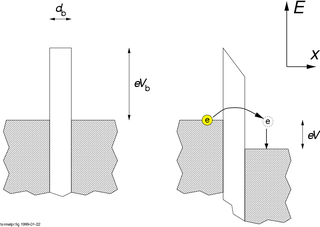 W
WIn mesoscopic physics, a Coulomb blockade (CB), named after Charles-Augustin de Coulomb's electrical force, is the decrease in electrical conductance at small bias voltages of a small electronic device comprising at least one low-capacitance tunnel junction. Because of the CB, the conductance of a device may not be constant at low bias voltages, but disappear for biases under a certain threshold, i.e. no current flows.
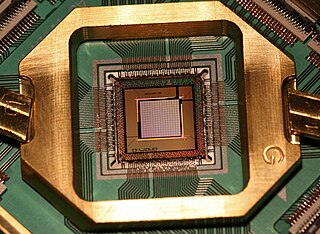 W
WThe Josephson junction count is the number of Josephson junctions on a superconducting integrated circuit chip. Josephson junctions are active circuit elements in superconducting circuits. The Josephson junction count is a measure of circuit or device complexity, similar to the transistor count used for semiconductor integrated circuits.
 W
WIn quantum computing, more specifically in superconducting quantum computing, flux qubits are micrometer sized loops of superconducting metal that is interrupted by a number of Josephson junctions. These devices function as quantum bits. The flux qubit was first proposed by Terry P. Orlando et al. at MIT in 1999 and fabricated shortly thereafter. During fabrication, the Josephson junction parameters are engineered so that a persistent current will flow continuously when an external magnetic flux is applied. Only an integer number of flux quanta are allowed to penetrate the superconducting ring, resulting in clockwise or counter-clockwise mesoscopic supercurrents in the loop to compensate a non-integer external flux bias. When the applied flux through the loop area is close to a half integer number of flux quanta, the two lowest energy eigenstates of the loop will be a quantum superposition of the clockwise and counter-clockwise currents.The two lowest energy eigenstates differ only by the relative quantum phase between the composing current-direction states. Higher energy eigenstates correspond to much larger (macroscopic) persistent currents, that induce an additional flux quantum to the qubit loop, thus are well separated energetically from the lowest two eigenstates. This separation, known as the "qubit non linearity" criteria, allows operations with the two lowest eigenstates only, effectively creating a two level system. Usually, the two lowest eigenstates will serve as the computational basis for the logical qubit.
 W
WIn solar cell research, carrier multiplication is the phenomenon wherein the absorption of a single photon leads to the excitation of multiple electrons from the valence band to conduction band. In the theory of a conventional solar cell, each photon is only able to excite one electron across the band gap of the semiconductor, and any excess energy in that photon is dissipated as heat. In a material with carrier multiplication, high-energy photons excite on average more than one electron across the band gap, and so in principle the solar cell can produce more useful work.
 W
WNanocrystal solar cells are solar cells based on a substrate with a coating of nanocrystals. The nanocrystals are typically based on silicon, CdTe or CIGS and the substrates are generally silicon or various organic conductors. Quantum dot solar cells are a variant of this approach, but take advantage of quantum mechanical effects to extract further performance. Dye-sensitized solar cells are another related approach, but in this case the nano-structuring is part of the substrate.
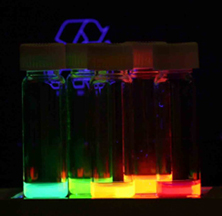 W
WQuantum dots (QDs) are semiconductor particles a few nanometres in size, having optical and electronic properties that differ from larger particles due to quantum mechanics. They are a central topic in nanotechnology. When the quantum dots are illuminated by UV light, an electron in the quantum dot can be excited to a state of higher energy. In the case of a semiconducting quantum dot, this process corresponds to the transition of an electron from the valence band to the conductance band. The excited electron can drop back into the valence band releasing its energy by the emission of light. This light emission (photoluminescence) is illustrated in the figure on the right. The color of that light depends on the energy difference between the conductance band and the valence band, or transition between discretized energy states when band structure is no longer a good definition in QDs.
 W
WA quantum dot display is a display device that uses quantum dots (QD), semiconductor nanocrystals which can produce pure monochromatic red, green, and blue light.
 W
WA quantum dot solar cell (QDSC) is a solar cell design that uses quantum dots as the absorbing photovoltaic material. It attempts to replace bulk materials such as silicon, copper indium gallium selenide (CIGS) or cadmium telluride (CdTe). Quantum dots have bandgaps that are tunable across a wide range of energy levels by changing their size. In bulk materials, the bandgap is fixed by the choice of material(s). This property makes quantum dots attractive for multi-junction solar cells, where a variety of materials are used to improve efficiency by harvesting multiple portions of the solar spectrum.
 W
WThe term quantum efficiency (QE) may apply to incident photon to converted electron (IPCE) ratio of a photosensitive device, or it may refer to the TMR effect of a Magnetic Tunnel Junction.
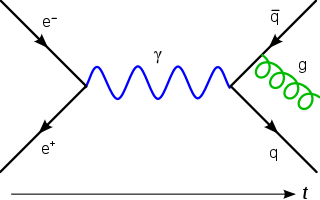 W
WIn particle physics, quantum electrodynamics (QED) is the relativistic quantum field theory of electrodynamics. In essence, it describes how light and matter interact and is the first theory where full agreement between quantum mechanics and special relativity is achieved. QED mathematically describes all phenomena involving electrically charged particles interacting by means of exchange of photons and represents the quantum counterpart of classical electromagnetism giving a complete account of matter and light interaction.
 W
WA Quantum Flux Parametron (QFP) is a digital logic implementation technology based on superconducting Josephson junctions. QFP's were invented by Eiichi Goto at the University of Tokyo as an improvement over his earlier parametron based digital logic technology, which did not use superconductivity effects or Josephson junctions. The Josephson junctions on QFP integrated circuits to improve speed and energy efficiency enormously over the parametrons.
 W
WA quantum heterostructure is a heterostructure in a substrate, where size restricts the movements of the charge carriers forcing them into a quantum confinement. This leads to the formation of a set of discrete energy levels at which the carriers can exist. Quantum heterostructures have sharper density of states than structures of more conventional sizes.
 W
WA quantum point contact (QPC) is a narrow constriction between two wide electrically conducting regions, of a width comparable to the electronic wavelength.
 W
WThe Quantum Vacuum: An Introduction to Quantum Electrodynamics is a physics textbook authored by Peter W. Milonni in 1993. The book provides a careful and thorough treatment of zero-point energy, spontaneous emission, the Casimir, van der Waals forces, Lamb shift and anomalous magnetic moment of the electron at a level of detail not found in other introductory texts to quantum electrodynamics.
 W
WA quantum well is a potential well with only discrete energy values.
 W
WA spin valve is a device, consisting of two or more conducting magnetic materials, whose electrical resistance can change between two values depending on the relative alignment of the magnetization in the layers. The resistance change is a result of the giant magnetoresistive effect. The magnetic layers of the device align "up" or "down" depending on an external magnetic field. In the simplest case, a spin valve consists of a non-magnetic material sandwiched between two ferromagnets, one of which is fixed (pinned) by an antiferromagnet which acts to raise its magnetic coercivity and behaves as a "hard" layer, while the other is free (unpinned) and behaves as a "soft" layer. Due to the difference in coercivity, the soft layer changes polarity at lower applied magnetic field strength than the hard one. Upon application of a magnetic field of appropriate strength, the soft layer switches polarity, producing two distinct states: a parallel, low-resistance state, and an antiparallel, high-resistance state.
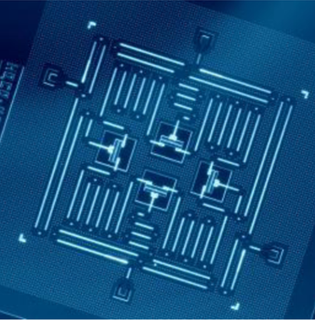 W
WSuperconducting quantum computing is an implementation of a quantum computer in superconducting electronic circuits. Research in superconducting quantum computing is conducted by companies such as Google, IBM, IMEC, BBN Technologies, Rigetti, and Intel. As of May 2016, up to nine fully controllable qubits are demonstrated in a 1D array, up to sixteen in a 2D architecture.
 W
WIn quantum computing, and more specifically in superconducting quantum computing, a transmon is a type of superconducting charge qubit that was designed to have reduced sensitivity to charge noise. The transmon was developed by Robert J. Schoelkopf, Michel Devoret, Steven M. Girvin and their colleagues at Yale University in 2007. Its name is an abbreviation of the term transmission line shunted plasma oscillation qubit; one which consists of a Cooper-pair box "where the two superconductors are also capacitatively shunted in order to decrease the sensitivity to charge noise, while maintaining a sufficient anharmonicity for selective qubit control".
 W
WIn electronics/spintronics, a tunnel junction is a barrier, such as a thin insulating layer or electric potential, between two electrically conducting materials. Electrons pass through the barrier by the process of quantum tunnelling. Classically, the electron has zero probability of passing through the barrier. However, according to quantum mechanics, the electron has a non-zero wave amplitude in the barrier, and hence it has some probability of passing through the barrier. Tunnel junctions serve a variety of different purposes.